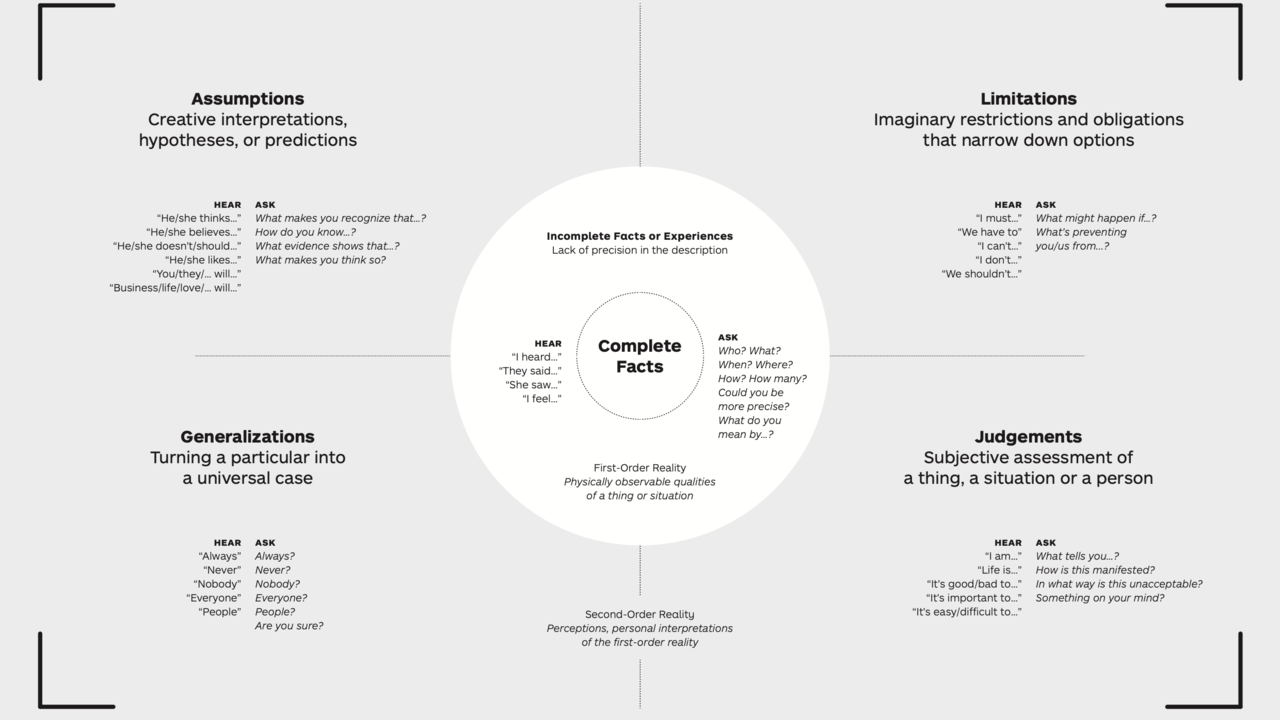Ask Right, Think Clear: Minimize Assumptions with The Fact Finder
Sep 16, 2020
By Stefano Mastrogiacomo
"The worst distance between two people
is misunderstanding."
We humans are naturally inclined to make assumptions, which are often the root cause of misunderstandings and conflicts in work teams.
This inclination stems from our imagination and our willingness to accept something as true without question or proof. In the workplace, this can lead to feelings of unfairness, erode mutual trust, and create unnecessary conflicts.
Understanding Assumptions and Facts
- Assumption: something accepted as true without question or proof, often leading to misunderstandings. Psychologists describe these as second-order realities.
- Fact: something tangible and known to have happened or to exist, described as first-order reality by psychologists.
The tendency to confuse facts and assumptions is common and occurs when we try to make sense of our experiences. Our sense-making process involves three stages: perception, interpretation, and evaluation. However, mixing these levels during communication can lead to several communication traps, including unclear facts, generalizations, assumptions, limitations, and judgements.
To avoid these traps and prevent unnecessary tension in teams, we must ask better questions. Specifically, clarification questions that help everyone understand the original facts and experiences hidden behind assumptions, judgements, and generalizations.
Introducing The Fact Finder

The Fact Finder is a tool designed to help avoid escalations by suggesting neutral questions that inquire and understand the facts hidden behind unproductive assumptions. This enables others to reformulate their thinking more accurately and be understood.
Mastering the Fact Finder can:
- Help identify and overcome typical language traps.
- Improve information gathering and decision-making.
- Make exchanges shorter and more efficient.
- Promote psychological safety by demonstrating genuine interest and by applying professional inquiry techniques to solve problems collaboratively.
Applying The Fact Finder
Using the Fact Finder involves two steps:
- Hear: Identify the trap. Are you hearing an assumption, limitation, generalization, judgement, or incomplete facts?
- Ask: Use one of the suggested clarifying questions to bring the conversation back to real facts and experiences.
The questions suggested by the Fact Finder are neutral and open, meaning they do not convey judgement or trigger closed binary responses (yes/no).
Examples (from High-Impact Tools for Teams)

To master the Fact Finder, focus on one communication trap each day. After one to two weeks of practice, you will be able to ask questions like a pro!
Take Action
Get your copy of High-Impact Tools for Teams, Wiley, Strategyzer Series, 2021.
Download the the Team Alignment Toolkit for free.
Origins of the Fact Finder
The Fact Finder has its roots in neuro-linguistic programming (NLP), a therapeutic communication approach developed by John Grinder and Richard Bandler in the 1970s. The challenging implementation of their "meta-model" led coach Alain Cayrol to develop a more applicable version, the Language Compass. Françoise Kourilsky, a French psychologist, further developed the tool, inspiring the Fact Finder presented in this book.
Credits
Illustrations by Severine Assous. Illustrissimo.fr
Reference
Kourilsky, F. (2014). Du désir au plaisir de changer: le coaching du changement. Dunod.

